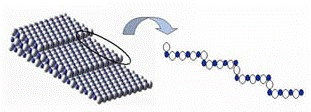Department of Chemistry
Date of this Version
9-15-2000
Abstract
Nickel cobaltite, NiCo2O4, has been synthesized by sol–gel and thermal decomposition techniques and the surface composition studied with Auger (AES) and X-ray photoelectron spectroscopies (XPS). The asintroduced samples are near-stoichiometric, although samples fabricated by thermal decomposition tend to be oxygen-defi cient by approximately 25% of the predicted spinel concentration. Nickel 2p XPS indicates the predominant form of the metal to be Ni2+, with the cations located in octahedral sites. The cobalt cations are equally divided between tetrahedral and octahedral sites as Co3+. The oxygen XP 1s spectrum is composed of two peaks, the main lattice peak at 529.6 eV and a component at 531.2 eV with about 40% of the total O 1s intensity in stoichiometric samples. While the possibility of hydroxyl contaminants cannot be discounted, most of the intensity in the 531.2 eV peak is believed to be intrinsic to the NiCo2O4 surface. Heating the cobaltite in ultrahigh vacuum (UHV) results in surface reduction, with the largest changes apparent in the Co 2p XP spectrum, which shows clear signs of reduction to octahedral Co2+. Changes brought about by the reduction are not reversible, and although it is possible to reoxidize the material, the surface undergoes phase separation to Co3O4 and NixCo1-xO.


Comments
Published in Applied Surface Science 165:1 (September 15, 2000), pp. 70-84; doi:10.1016/S0169-4332(00)00378-0 Copyright © 2000 Elsevier Science B.V. Used by permission. http://www.sciencedirect.com/science/journal/01694332